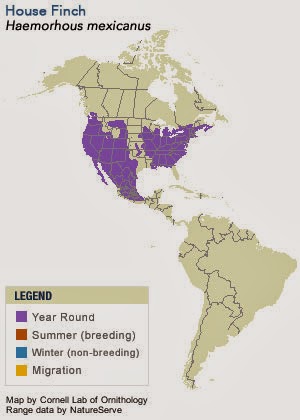Size & Shape
House Finches are small-bodied finches with fairly large beaks and somewhat long, flat heads. The wings are short, making the tail seem long by comparison. Many finches have distinctly notched tails, but the House Finch has a relatively shallow notch in its tail.
Color Pattern
Adult males are rosy red around the face and upper breast, with streaky brown back, belly and tail. In flight, the red rump is conspicuous. Adult females aren’t red; they are plain grayish-brown with thick, blurry streaks and an indistinctly marked face.
Behavior
House Finches are gregarious birds that collect at feeders or perch high in nearby trees. When they’re not at feeders, they feed on the ground, on weed stalks, or in trees. They move fairly slowly and sit still as they shell seeds by crushing them with rapid bites. Flight is bouncy, like many finches.
Habitat
House Finches frequent city parks, backyards, urban centers, farms, and forest edges across the continent. In the western U.S., you’ll also find House Finches in their native habitats of deserts, grassland, chaparral, and open woods.


.jpg)
.jpg)




Comments
Post a Comment